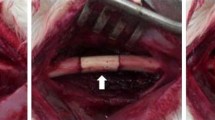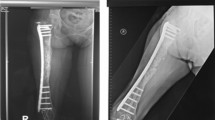Abstract
We evaluated the biological characteristics/effect of human umbilical cord-derived mesenchymal stem cells (hUC-MSCs) grafting with blood plasma on bone regeneration in rat tibia nonunion. SD rats (142) were randomly divided into four groups: fracture group (positive control); nonunion group (negative control); hUC-MSCs grafting with blood plasma group; and hUC-MSCs grafting with saline group. Rats were administered tetracycline (30 mg/kg) and calcein blue (5 mg/kg) 8 days before killing. The animals were killed under deep anesthesia at 4 and 8 weeks post fracture for radiological evaluation and histological/immunohistological studies. The hUC-MSCs grafting with blood plasma group was similar to fracture group: the fracture line blurred in 4 weeks and disappeared in 8 weeks postoperatively. Histological/immunohistological studies showed that hUC-MSCs were of low immunogenicity which merged in rat bone tissue, differentiated into osteogenic lineages, and completed the healing of nonunion. After stem cell transplantation, regardless of whether plasma or saline was used, new multi-center bone formation was observed; fracture site density was better in stem cell grafting with blood plasma group. We, therefore, concluded that the biological characteristics of hUC-MSCs-treated nonunion were different from the standard fracture healing process, and the proliferative and localization capacity of hUC-MSCs might benefit from the use of blood plasma.








Similar content being viewed by others
References
Einhorn, T. A. (1995). Enhancement of fracture healing. Journal of Bone and Joint Surgery, 77, 940–956.
Coles, C. P., & Gross, M. (2000). Closed tibial shaft fractures: Management and treatment complications. A review of the prospective literature. Canadian Journal of Surgery, 43, 256–262.
Hadjiargyrou, M., Ahrens, W., & Rubin, C. T. (2000). Temporal expression of the chondrogenic and angiogenic growth factor CYR61 during fracture repair. Journal of Bone and Mineral Research, 15, 1014–1023.
Younger, E. M., & Chapman, M. W. (1989). Morbidity at bone graft donor sites. Journal of Orthopaedic Trauma, 3, 192–195.
Grundel, R., Chapman, M., Yee, T., & Moore, D. C. (1991). Autogeneic bone marrow and porous biphasic calcium phosphate ceramic for segmental bone defects in the canine ulna. Clinical Orthopedics and Related Research, 266, 244–258.
Werntz, J., Lane, J., Burstein, A., Justin, R., Klein, R., & Tomin, E. (1996). Qualitative and quantitative analysis of orthotopic bone regeneration by marrow. Journal of Orthopedic Research, 14, 85–93.
Muschler, G. F., Hiromori, N., Matsukura, Y., et al. (2003). Spine fusion using cell matrix composites enriched in bone marrow-derived cells. Clinical Orthopedics and Related Research, 407, 102–118.
Arinzeh, T. L., Peter, S. J., Archambault, M. P., et al. (2003). Allogeneic mesenchymal stem cells regenerate bone in a critical-sized canine segmental defect. Journal of Bone and Joint Surgery, 85-A, 1927–1935.
Bruder, S. P., Kurth, A. A., Shea, M., Hayes, W. C., Jaiswal, N., & Kadiyala, S. (1998). Bone regeneration by implantation of purified, culture-expanded human mesenchymal stem cells. Journal of Orthopedic Research, 16, 155–162.
Pittenger, M. F., Mackay, A. M., Beck, S. C., et al. (1999). Multi-lineage potential of adult human mesenchymal stem cells. Science, 284, 143–147.
Mitchell, K. E., Weiss, M. L., Mitchell, B. M., et al. (2003). Matrix cells from Wharton’s jelly form neurons and glia. Stem Cells, 21, 50–60.
Sarugaser, R., Lickorish, D., Baksh, D., Hosseini, M. M., & Davies, J. E. (2005). Human umbilical cord perivascular (HUCPV) cells: A source of mesenchymal progenitors. Stem Cells, 23, 220–229.
Wang, H. S., Hung, S. C., Peng, S. T., et al. (2004). Mesenchymal stem cells in the Wharton’s jelly of the human umbilical cord. Stem Cells, 22, 1330–1337.
Qu, Z. G., Mi, S. F., & Fang, G. J. (2009). Clinical study on treatment of bone nonunion with MSCs derived from human umbilical cord. Chinese Journal of Reparative and Reconstructive Surgery, 23(3), 345–347 (in Chinese).
Mariane, S., Yuri, B. M., Eder, Z., et al. (2009). Gene expression profile of mesenchymal stem cells from paired umbilical cord units: Cord is different from blood. Stem Cell Review, 5, 387–401.
Qu, Z. G., Liu, Y., Guo, L., et al. (2009). Percutaneous radiological autologous bone-marrow mesenchymal stem cells grafting integrating with blood plasma by injection in the part of thigh fracture: Seven-month follow-up effect evaluation in one case. Journal of Clinical Rehabilitative Tissue Engineering Research, 13, 7393–7396.
Wang, C. J., Iida, K., Egusa, H., Hokugo, A., Jewett, A., & Nishimura, I. (2008). Trabecular bone deterioration in col9a1 ± mice associated with enlarged osteoclasts adhered to collagen IX–deficient bone. Journal of Bone and Mineral Research, 23, 837–849.
Kratzel, C., Bergmann, C., Duda, G., Greiner, S., Schmidmaier, G., & Wildemann, B. (2008). Characterization of a rat osteotomy model with impaired healing. BMC Musculoskeletal Disorders, 9, 135.
Ren, H. Y., Zhao, Q. J., Xing, W., et al. (2010). Differentiation of human umbilical cord derived mesenchymal stem cells into low immunogenic and functional hepatocyte-like cells in vitro. Zhongguo Yi Xue Ke Xue Yuan Xue Bao, 32, 190–194.
Tipnis, S., Viswanathan, C., & Majumdar, A. S. (2010). Immunosuppressive properties of human umbilical cord-derived mesenchymal stem cells: role of B7-H1 and IDO. Immunology and Cell Biology, 88, 795–806.
Chen, K., Wang, D., Du, W. T., et al. (2010). Human umbilical cord mesenchymal stem cells hUC-MSCs exert immunosuppressive activities through a PGE2-dependent mechanism. Clinical Immunology, 135, 448–458.
Acknowledgments
We thank all the cord blood donors as well as hospital support staff for their cooperation.
Author information
Authors and Affiliations
Corresponding author
Rights and permissions
About this article
Cite this article
Qu, Z., Guo, L., Fang, G. et al. Biological Characteristics and Effect of Human Umbilical Cord Mesenchymal Stem Cells (hUC-MSCs) Grafting with Blood Plasma on Bone Regeneration in Rats. Cell Biochem Biophys 63, 171–181 (2012). https://doi.org/10.1007/s12013-012-9354-1
Published:
Issue Date:
DOI: https://doi.org/10.1007/s12013-012-9354-1




